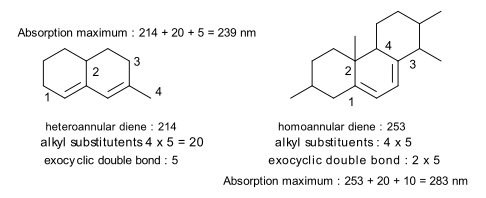Woodward's rules
Woodward's rules, named after Robert Burns Woodward and also known as Woodward–Fieser rules (for Louis Fieser) are several sets of empirically derived rules which attempt to predict the wavelength of the absorption maximum (λmax) in an ultraviolet–visible spectrum of a given compound. Inputs used in the calculation are the type of chromophores present, the substituents on the chromophores, and shifts due to the solvent.[1][2] Examples are conjugated carbonyl compounds,[3][4][5] conjugated dienes,[3][6] and polyenes.[3][5]
Implementation
One set of Woodward–Fieser rules for dienes is outlined in table 1. A diene is either homoannular with both double bonds contained in one ring or heteroannular with two double bonds distributed between two rings.
| Structural feature | λmax effect (in nanometers) |
|---|---|
| Base value for heteroannular diene | 214 |
| Base value for homoannular diene | 253 |
| Increments | |
| Double bond extending conjugation | + 30 |
| Alkyl substituent or ring residue | + 5 |
| Exocyclic double bond | + 5 |
| acetate group | + 0 |
| Ether group | + 6 |
| Thioether group | + 30 |
| bromine, chlorine | + 5 |
| secondary amine group | + 60 |
With the aid of these rules the UV absorption maximum can be predicted, for example in these two compounds:[8]

In the compound on the left, the base value is 214 nm (a heteroannular diene). This diene group has 4 alkyl substituents (labeled 1,2,3,4) and the double bond in one ring is exocyclic to the other (adding 5 nm for an exocyclic double bond). In the compound on the right, the diene is homoannular with 4 alkyl substituents. Both double bonds in the central B ring are exocyclic with respect to rings A and C.
For polyenes having more than 4 conjugated double bonds one must use Fieser–Kuhn rules.[3]
References
- ↑ Woodward, Robert Burns (1941). "Structure and the Absorption Spectra of α,β-Unsaturated Ketones". J. Am. Chem. Soc. 63 (4): 1123. doi:10.1021/ja01849a066.
- ↑ Louis F. Fieser; Mary Fieser; Srinivasa Rajagopalan (1948). "Absorption Spectroscopy and the Structures of the Diosterols". J. Org. Chem. 13 (6): 800–6. doi:10.1021/jo01164a003. PMID 18106021.
- 1 2 3 4 5 Mehta, Akul (5 Aug 2012). "Ultraviolet–Visible (UV–Vis) Spectroscopy – Woodward–Fieser Rules to Calculate Wavelength of Maximum Absorption (Lambda-max) of Conjugated Carbonyl Compounds". PharmaXChange.info.
- ↑ Neil Glagovich (2007-07-19). "Woodward's Rules for Conjugated Carbonyl Compounds". Central Connecticut State University. Archived from the original on April 10, 2008. Retrieved 2008-05-05.
- 1 2 William Reusch. "UV–Visible Spectroscopy". VirtualText of Organic Chemistry. Michigan State University.
- ↑ Neil Glagovich (2007-07-19). "Woodward–Fieser Rules for Dienes". Central Connecticut State University. Archived from the original on April 10, 2008. Retrieved 2008-05-05.
- ↑ Spectroscopic Determination of Organic Compounds, 5th Edition, Silverstein, Bassler, Morrill 1991
- ↑ Organic spectroscopy William Kemp